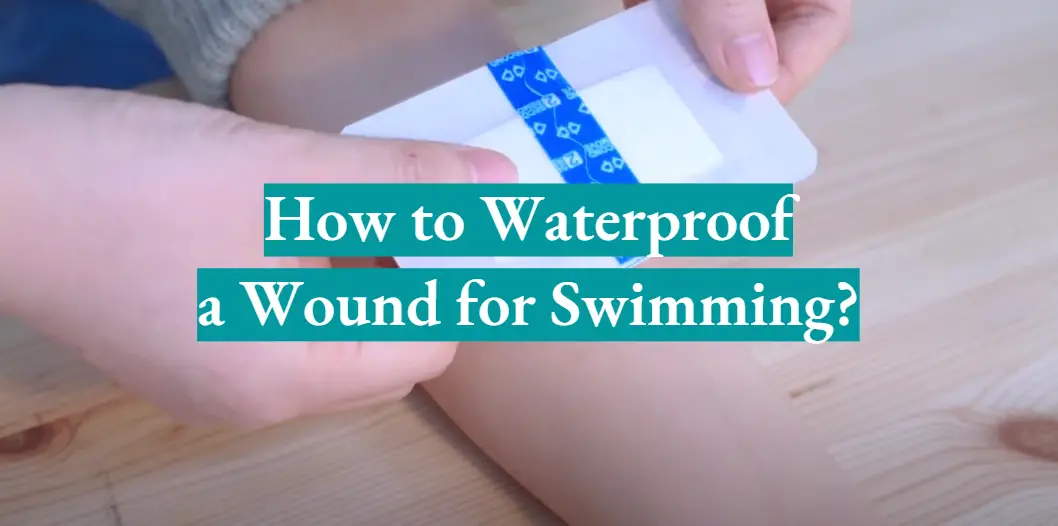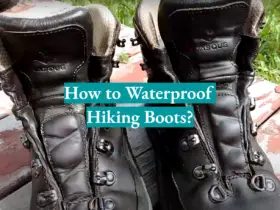Why Do You Need to Cover Wounds When Swimming?
Many people like to go swimming, even with open wounds. While it can be fun and refreshing, water entering the wound through your bandage could cause infections or other issues.
If you have a cut on your hand that is just healing up nicely, then taking it into the pool is never recommended as this will not only clean out any dirt but also introduce harmful bacteria into the body which may lead to an infection of sorts.
Also, if someone has some sort of play injury such as scrapes on their knees from falling off their bike while biking around town these are best kept away from water because they are still somewhat bleeding or oozing blood so they need time to heal first before exposing them again in any way!
It is important to cover wounds when swimming because:
- This will prevent bacteria from entering the body through water;
- This can help avoid infections or other issues that could develop if a wound gets wet and dirty;
- Those with an open wound should not go into any bodies of water, especially pools where there are many people using it as well which increases the risk for contamination and infection even further;
- Keeping cuts away from water also helps heal them faster so they do not become worse than what they started out as originally;
Covering Your Wound
If you want to know how to waterproof a wound for swimming, then the most important thing that you need is waterproof bandages or tape. This will be your outermost layer of defense against water seeping into the cut on your skin and causing irritation.
These are preferable over petroleum jelly because they don’t become gummy if exposed to water for long periods of time, whereas petroleum jelly does this when it becomes diluted by all the pool chemicals in addition to being less effective at providing protection from infection-causing bacteria entering through an open wound while submerged in chlorinated pools.
Here is how you may cover your wound:
- Cover the wound on your skin with a waterproof bandage or tape. You want to make sure that you do not cut off airflow from this area of your body by using too many layers either. There should be some air circulation present for it to heal properly and allow excess fluid such as pus (i.e., white blood cells) built up in order to drain out of the open lesion without becoming trapped under any covering material which could lead to further infection.
- You want to make sure that your outermost layer of clothing is wicking and not cotton since water will be coming into direct contact with the wound. The cotton fabric absorbs moisture; whereas a material such as nylon or polyester would allow for better transfer of perspiration away from the skin in order to keep it dry (the latter being preferred).
- If you do get any chlorinated pool water onto an open cut on your body while swimming, then just wash it off immediately with fresh tap water before drying the area thoroughly. Although there are no studies proving this yet, some doctors say that putting alcohol on a fresh wound could cause nerve/tissue damage [1] since doing so inhibits blood flow which can affect how quickly new cells grow around the area that has been cut.
About Waterproof Plasters
Swimming pools are dangerous for wound healing. The chlorine in the water can damage your skin, so it is important to protect against any open injuries before swimming.
Waterproof plasters are waterproof bandages that provide protection against water in the pool. They can be applied over wounds, cuts, and grazes to keep them dry when you enter the swimming pool or bathtub. Waterproof plasters are made specifically for protecting open injuries from exposure to chemicals found in pools or chlorinated tap water. Regular adhesive dressings will not protect your wound if exposed to these chemicals, so always make sure you have a suitable product before entering any kind of chlorinated environment.
Many different brands produce waterproof plasters – an example is Elastoplast. The instructions on how best to apply them should come with your purchase. A waterproof plaster will prevent contact with chlorinated water and allow you to swim in a pool without fear of infection or irritation. Such plasters are typically flexible and will not be affected by the water.
Here is how you can use a waterproof plaster:
- You should clean your wound before the application of plaster, to avoid any other contaminants getting into it. Pat dry with a paper towel or cotton wool after cleaning;
- Do not rub the area dry as this can cause irritation;
- Apply an even layer of antiseptic cream over the entire surface (not just around the edge) where you intend to place your plaster;
- Leave about half an inch between this and healthy skin surrounding your injury – otherwise, there is a risk that bacteria may spread across larger areas causing infection in more than one part of your body at once! This must be allowed time to sink in, so wait until it has dried fully before applying a waterproof plaster;
- The most important thing you must do before applying plaster is to ensure that your injury is completely dry;
When Not to Swim with a Wound
- If you have open wounds or sores that can get in the water;
- If your wound is still bleeding;
- If your wound is still red;
- If you have stitches that are still in place, avoid swimming until they are removed by a doctor;
- If your skin is too sensitive or fragile to be exposed frequently to chlorine, saltwater, and other pool chemicals;
- If you have a wound on your head or face;
- Avoid swimming with an ear infection, unless it is treated by a doctor beforehand so there won’t be any complications when in contact with water;
Check the Water Condition if You Have a Wound
As you know, there are many types of wounds. You can get a wound from an accident or injury and it causes pain as well as the risk of infection. However, if you have a cut on your skin when swimming in open water such as lakes, oceans, or rivers, for example, this can cause problems especially if the wound is exposed to dirty and contaminated water that may increase the risk of infections like tetanus.
If you want to go for a swim even without having a wound then here experts will give some tips about how to waterproof a wound during swimming:
- Make sure that before going into fresh waters (lakes, rivers, etc.) you apply antibiotic ointment onto your wounded area at least 1 hour prior to entering the water;
- It is important to cover the wounded area with a waterproof bandage or tape so that no water can seep in and reach your wound. You should keep the covered taped on for at least 24 hours but if there are any signs of swelling you need to remove them right away;
- Swimmers who want to go into open waters (lakes, rivers) should consider using protective clothing like wetsuits that will help reduce their risk of getting wounds when swimming. Because these types of clothes provide protection not only for dressing up but also act as an extra layer that protects against infections after diving into freshwaters especially during cold seasons where people tend to cut themselves more easily due to dry skin;
FAQ
Can you swim with a healing wound?
Swimming is an excellent form of exercise. It’s fun, easy on your joints, and can be done almost anywhere. However, you’ll probably want to avoid the water if you’re healing from a wound or injury. Not only will saltwater make it sting, but chlorine in swimming pools could irritate the open sore even more. If you hurt yourself and need to stay out of the water, there are ways for you to swim without getting your bandage wet.
Waterproof bandages exist for this very purpose. They cover the wound and prevent water from seeping in while you’re swimming, but they also allow your body to breathe so that it doesn’t get too hot or sweaty underneath. In fact, some of them are even designed with a cooling gel inside so that when sweat accumulates on the surface, the pad releases moisture through evaporation which keeps you cool during your workout session!
If you don’t have access to these special bandages (which can be expensive) there is another option available: waterproof tape. Much like regular medical tape, waterproof tapes stick onto skin without causing discomfort and come off painlessly as soon as they’ve done their job. These kinds of tapes are usually made out of plastic and although they’re not designed specifically for wounds, they can do a pretty good job at keeping water away.
Just ensure to change the tape regularly (or more frequently if it’s visibly accumulating moisture) to prevent infection from building up underneath; discard your old bandage in an environmentally safe manner when you no longer need it.
Can you swim in a pool with an open wound?
Wounds should not be exposed to water for at least 48 hours while they are still open [2]. Swimming in a pool with an active wound can increase the risk of infection, including tetanus or Hepatitis B and C. It is important to clean cuts thoroughly before swimming in order to remove any bacteria that might have been introduced into the environment by other swimmers.
Can you swim with a waterproof dressing?
If your wound is small and covered with a waterproof dressing, swimming is just fine.
Do waterproof bandages keep water out?
A typical waterproof bandage does not keep water out. The best product, Nexcare Clear, keeps water out more than 60% of the time. Band-Aid is worse, leaking approximately one-fourth of the time and Nexcare about one-fifth of the time. When compared to less-rated products, lower ratings result in greater leaks (about 40% of Nexcare vs. 1% for Band-Aid) [3].
How do you waterproof a wound for a shower?
To waterproof a wound for showering:
- Clean the area with soap and water;
- Apply an antibiotic ointment to help prevent infection or irritation from occurring;
- Cover the cut with adhesive bandages, gauze pads covered in petroleum jelly, plastic wrap, or aluminum foil;
- Ensure that this material is secure around your skin by using medical tape along the edges of each covering option you choose;
- If it gets wet while you are taking a shower do not remove any type of dressing because doing so will increase the risk of developing further complications such as bleeding and/or infections;
- Continue to keep these dressings on until they fall off naturally;
Is ocean water good for wounds?
No. It can irritate the wound and cause infection if not treated properly. Water and open wounds are a bad mix. Whether it’s a pool, a lake, or the sea, stay away from the water until your wound has healed.
How long can you leave a waterproof bandage on?
You can leave a waterproof bandage on for days at a time. However, you should change it or add more ointment (if your doctor has prescribed one) every day to prevent infection and promote healing. Two days after surgery, you can take off the cushioned dressings. However, keep your waterproof ones on for ten days [4].
Is Band-Aid waterproof?
The BAND-AID WATER BLOCK Adhesive Bandages are waterproof, so they stay on even when wet. The pad is kept dry by the four-sided adhesive that keeps the pad clean while blocking water, dirt, and germs from your cut [5].
How do you remove a waterproof bandage painlessly?
A cotton ball or swab soaked in baby oil should suffice. If you don’t have any baby oil, olive oil, petroleum jelly, or baby shampoo on hand, you can use plain water instead. Rub the bandage with a light touch until it comes off.
Useful Video: How to Shower with a Cast or Splint?
References:
- https://www.spokesman.com/stories/2020/feb/08/ask-the-doctors-no-need-to-use-rubbing-alcohol-on-/
- https://www.healthlinkbc.ca/health-topics/sid42906
- https://www.consumerreports.org/cro/2012/12/few-waterproof-bandages-make-the-cut/index.htm
- https://www.windsorupperlimb.com/faq/the-first-2-weeks-after-surgery
- https://www.band-aid.com/products/water-block/plus-waterproof-bandages-30-ct-assorted






Leave a Reply